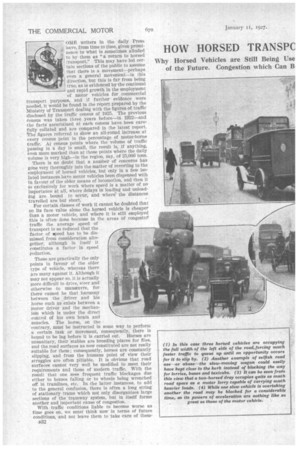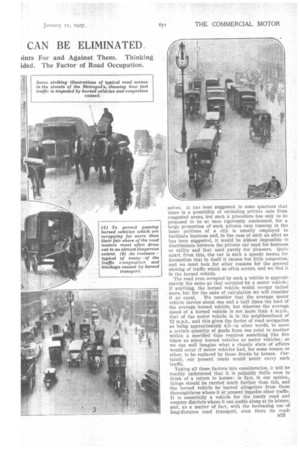HOW HORSED TRANSPC
Page 52

Page 53

Page 54

If you've noticed an error in this article please click here to report it so we can fix it.
CAN BE ELIMINATED, \Thy Horsed Vehicles are Still Being Use of the Future. Congestion which Can 11,
Ants For and Against Them. Thinking ided. The Factor of Road Occupation.
OMB writers in the daily Press . have, from time to time, given promi nence to what is sometimes alluded to by them as "a return to horsed Transport." This may have led cerra in sections of the public to assume Ihat there is a movement—perhaps even a general movement—in this /direction, but this is far from being true, as is evidenced by the continual and rapid growth in the employment of motor vehicles for commercial transport purposes, and if further evidence were needed, it would be found in the report prepared by the Ministry of Transport dealing with the figures of traffic disclosed by the traffic census of 1925. The previous eensus was taken three years before—in 1922—and the facts ascertained at each census have been carefully collated and are compared in the latest report. thefigures referred to show an all-round increase at every census point in the percentage of motor-borne traffic. At census points where the volume of traffic passing in a day is small, the result is, if anything, even more marked than at those points where the daily Volume is very high—in the region, say, of 25,000 tons.
There is no doubt that a number of concerns has gone very thoroughly into the matter of reverting to the employment of horsed vehicles, but only in a few isolated instances have motor vehicles been dispensed with in favour of the older means of locomotion, and then it is exclusively for work where speed is a matter of no importance at all, where delays in loading and unloading are bound to occur, and where the distances travelled are but short. ...
For certain classes of work it cannot be doubted that on its face value alone the horsed vehicle is cheaper than a motor vehicle, and where it is still employed this is often done because in the areas of congestcti traffic the average speed of transport is so reduced that the factor of speed has to be dismissed from consideration altogether, although in itself it constitutes a factor in speed reduction.
These are practically the only points in favour of the older type a vehicle, whereas there Are many against it. Although it may not appear so, it is actually more difficult to drive, steer and otherwise to manceuvre, for there cannot be that harmony between the driver and his horse such as exists between a motor driver and the mechanism which is under the direct control of his own brain and muscles. The horse, on the contrary, must be instructed in some way to perform a certain task or movement, consequently, there is bound to be lag before it is carried out. Horses are unsanitary, their -stables are breeding places for flies, and the road surfaces as now constituted are not really suitable for them ; consequently, horses are constantly slipping, and from the humane point of view their struggles are often pitiable. It is obvious that road surfaces cannot very well be modified to meet their requirements and those of modern traffic. With the result that one sees frequent traffic blockages due either to horses falling or to wheels being wrenched off in tramlines, etc. In the latter instances, to add to the general confusion, there is often a long string of stationary trams which not only disorganizes large sections of the tramway system, but in itself forms another and important cause of congestion.
With traffic conditions liable to become worse as time goes on, we must think now in terms of future conditions, and not leave them to take care of them selves, it has been suggested in some quarters that there is a possibility of excluding private cars from congested areas, but such a procedure has only to be proposed to be at once rigorously condemned, for a large proportion of such private cars running in the inner portions of a city is usually employed to facilitate business and, in the case of such an edict as has been suggested, it would be almost impossible to discriminate between the private car used for business or utility and that used purely for pleasure. Quite apart from this, the car is such a speedy means for locomotion that in itself it causes but little congestion, and we must look for other reasons for the general slowing of traffic which so often occurs, and we find it in the horsed vehicle.
The road area occupied by such a vehicle is approximately the same as that occupied by a motor vehicle; if anything, the horsed vehicle would occupy rather more, but for the sake of calculation we will consider it as equal. We consider that the average motor vehicle carries about one and a half times the load of the average horsed vehicle, but whereas the average speed of a horsed vehicle is not more than 4 m.p.h., that of the motor vehicle is in the neighbourhood of 12 m.p.h., and this gives the factor of road occupation as being approximately 45--in other words, to move a certain quantity of goods from one point to another within a specified time requires something like five times as many horsed vehicles as motor vehicles; so we can well imagine what a chaotic state of affairs would occur if motor vehicles had, for some reason or other, to be replaced by those drawn by horses. Certainly, our present roads would never carry such traffic.
Taking all these factors into consideration, it will be readily understood that it is palpably futile even to think of a return to horses; in fact, in our opinior., things should be carried much farther than this, and the horsed vehicle be barred altogether from those thoroughfares where it at present impedes other traffic. It is essentially a vehicle for the lonely road and country districts where it can amble along at its leisure, and, as a matter of fact, with the increasing use of long-distance road transport, even there its road wasting propensities might eventually have to be curbed, but, where the volume of traffic is great, it merely serves to prevent faster vehicles from making proper use of their speed capabilities. How often one sees slow-moving units occupying far more than their rightful share of the road, followed by quite a queue of motors! In fact, this is almost a general rule, owing to the absence of power on the part of the police to order slow-moving traffic to the sides of the road.
It would certainly inflict severe hardships on the owners and users of such vehicles if this suggestion to exclude horsed traffic from scheduled streets and roads were carried out immediately and without some form of compensation. Therefore, as we suggested in an editorial which was published in our issue of last week, we consider that a time limit should be given and that, in any ease where a change-over might constitute a heavy burden, compensation should be given in the form of a subsidy from the Road Fund, such subsidy not being given in a lump sum, but being spread over a period of, say, three years. We estimate that the • total sum required would not be more than i250,000 a year, , and its contributors—the other users of the road —would have the consolation of knowing that the money expended would certainly do much to facilitate the running of their vehicles, the more expedi tious delivery and receipt of their goods and that it would not be diverted to other civil uses. We believe that, in actual fact, many present users of the horsed vehicle would ultimately benefit to a very considerable extent by the employment of the faster means of transport, for the retention of the slower type of vehicle is often due rather to a disinclination to face possible risks in the adoption of mechanicalized road transport than to the wish to retain the horsed vehicle or to any great belief in its value.
There is one particular danger with the horsed B34 vehicle due to its comparatively narrow iron tyres. This is the swinging out of the rear of the vehicle, which so often occurs when a wheel catches in the tramlines. We have already alluded to wheels being wrenched off in this mahner, but this is more a cause of further congestion than of added danger, whereas the swinging may necessitate most skilful manceuvring on the part of vehicles following or passing.
When considering the matter of subsidizing owners who are replacing horsed vehicles by motors, it must be remembered that such a process is not likely to take place with extreme rapidity. It will probably be a question more of infiltration than drastic changes; as a matter of fact, many users employ both methods of transport, in which case it will simply mean a gradual reduction on the horse side and a corresponding growth of mechanical transport.
A considerable amount of the
congestion at docks an d in loading bays can be blamed on transport which cannot be manceuvred with the same ease as a motor vehicle, has practically no powers of acceleration and occupies far more space for the conveyance of a given quantity of goods. If horsed vehicles were barred from the docks and from the aft en narrow streets which lead to and from 'them, much of the problem of dock transport, which is now almost a, critical one, would be solved without recourse to expensive road widening.
Few users of the road but can have noticed how much obstruction is caused when one slow-moving vehicle overtakes another. The time occupied in performing such a mancenvre is very much longer than Is the case when the means for transport is rapid.
It is quite possible that some of our readers may have valuable views on this subject, or useful and interesting suggestions to make, and we shall be very pleased to give these publicity in our columns.




































































































